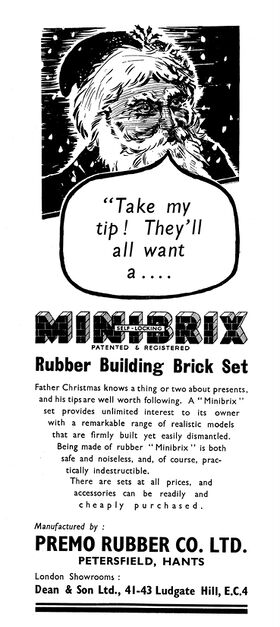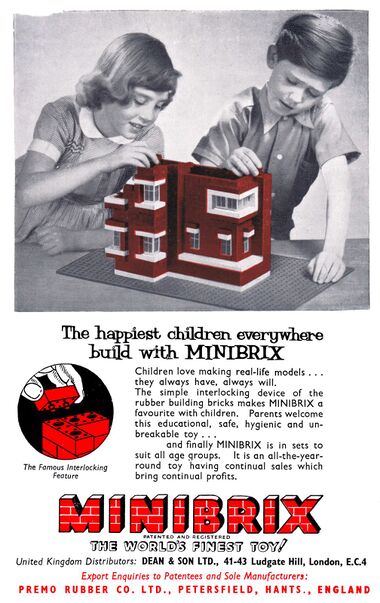Category:Minibrix
| Toy Brands and Manufacturers |
|---|
Minibrix |
| 1935 - 1976 |
1939 Minibrix trade advert [image info]
1956 Minibrix trade advert [image info]
Minibrix (1935-1976), from the Premo Rubber Company, was an architectural building set system that represented an early attempt to make a new type of construction kit using new Twentieth-Century materials. The products were distributed for at least part of their life by Dean and Son Ltd of Ludgate Hill, London.
1939 promotional text:
A "Minibrix" set provides unlimited interest to its owner with a remarkable range of realistic models that are firmly built yet easily dismantled. Being made of rubber "Minibrix" is both safe and noiseless, and, of course, practically indestructable.
There are sets at all prices, and accessories can be readily and cheaply purchased.
Minibrix vs Lego
Minibrix is sometimes described as being "the first Lego", but the design requirements of the different material used (rubber) put Minibrix into a different category to Lego (or, more accurately, to the Kiddicraft system designed by Hilary Page that Lego "borrowed").
- Minibrix blocks are mostly solid (thanks to the cheap material), whereas Lego bricks are hollow (for injection moulding).
- Lego bricks have their studs at the top (to hide the hollow base), whereas Minibrix blocks are usually stacked "hole-up", on a base with holes, to hide their slightly odd-looking plungers.
- Lego/Kiddicraft "brick" pieces have eight studs, allowing the bricks to be stacked and joined in multiple ways, whereas Minibrix housebrick-style bricks only have two plungers.
While both systems are washable, it was slightly disingenuous of Premo to describe their system as "hygienic", as the suggestion for what to do it temperature variations made the blocks difficult to fit together was to "wet" the plungers slightly, which would probably be done my most builders with the help of a judicious dab of saliva. So when playing with someone else's Minibrix set, one had to bear in mind that they were probably already coated with a thin layer of the previous owner's bodily fluids.
Obsolescence
Faced with the competition from Airfix plastic building kits and Lego plastic building blocks, Minibrix was never going to be able to compete in the long term. Its main initial advantage was that it could be made using low-tech and not especially accurate equipment (with workers having to manually trim the flash off the corners of each block) whereas injection moulding, although it required an outlay on specialised equipment, could then churn out Lego blocks 24/7 with no further human processing required. Making rubber blocks made sense if one was already a rubber manufacturing company, but the higher-tech injection moulding approach, with bricks that were more stable, more rigid, more long-lasting, and which lent themselves to the rigid attachment of a wider range of accessories such as wheels and wings, were always going to ultimately win out.
Minibrix had a fun tactile element (and a distinctive smell and taste!) but until one added injection-moulded parts such as windows, it didn't have the architectural sophistication of a system like Bayko, and also didn't have the same general-purpose utility as Lego for making cars and planes and boats and spaceships.
In the Museum
The museum displays includes two built Minibrix buildings and a range of packaging and instruction manuals, in Arch Two.
External links
Media in category ‘Minibrix’
The following 5 files are in this category, out of 5 total.
- Minibrix (MM 1958-09).jpg 3,014 × 2,156; 700 KB
- Minibrix (MM 1958-10).jpg 3,028 × 2,175; 753 KB
- Minibrix, Premo Rubber Co (GaT 1939-11).jpg 983 × 2,200; 326 KB
- Minibrix, Premo Rubber Company (GaT 1956).jpg 1,008 × 1,600; 307 KB









